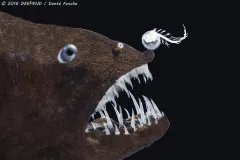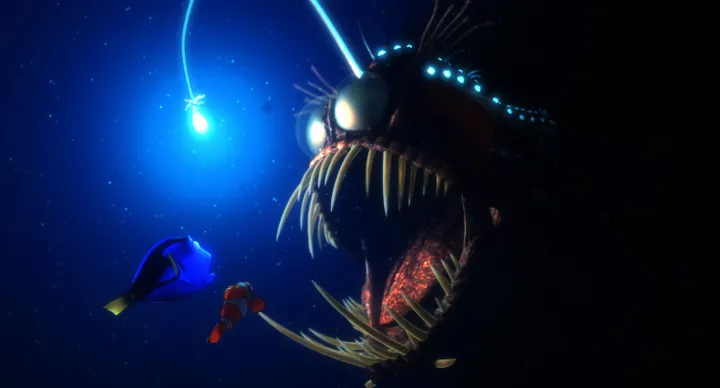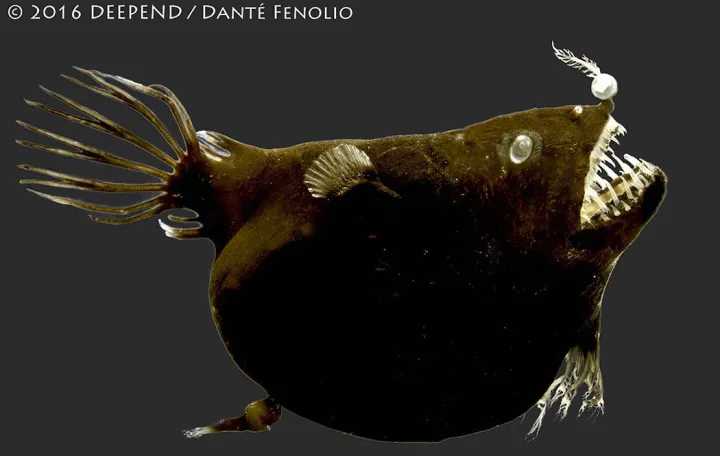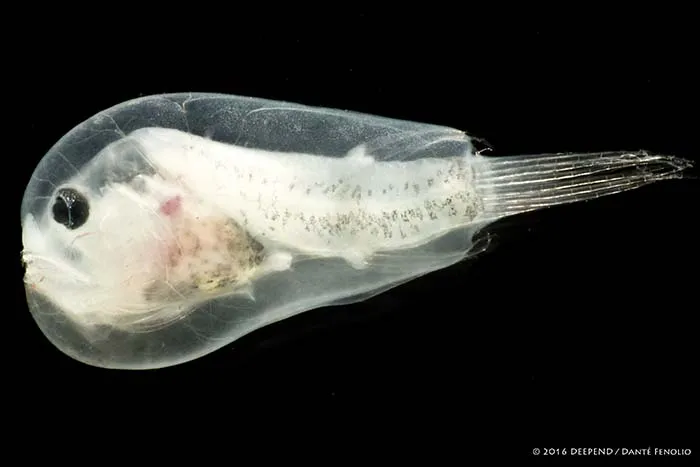Meet the Tiny Bacteria That Give Anglerfishes Their Spooky Glow

Descend two hundred meters (about 656 feet) below the surface and the ocean is reduced to total darkness. Creatures that live beyond the Twilight Zone spend their lives almost entirely in a near-limitless black expanse, save for a group of luminous fishes, invertebrates and bacteria that have evolved a special adaptation: bioluminescence.
Bioluminescence is the predominant source of light in the largest fraction of the habitable volume of the earth—the deep ocean. It’s thought that 90 percent of open ocean organisms produce light of some kind, and that this ability that has evolved many times. It serves a few predictable purposes, like possibly signaling to members of the same species or illuminating prey, along with some capricious ones like the ability to eject luminescent body parts in order to distract a predator.
Some organisms, like the lanternfish, can produce the chemicals needed to maintain an onboard headlamp. But what happens when a bioluminescent animal can’t make its own light?
Sea creatures like the bobtail squid are one of many that rely on symbiotic bacteria to help them illuminate the darkness. "The squid emit ventral luminescence that is often very, very close to the quality of light coming from the moon and stars at night," explains Margaret McFall-Ngai, professor of medical microbiology and immunology at the University of Wisconsin-Madison in an online article. If a predator looks up from below, the squid is able to seamlessly disappear among the starlight.
Arguably one of the most well-recognized creatures of the deep, some species of anglerfish have developed a creative workaround capitalizing off “borrowed” bioluminescence to attract and capture prey. Tiny glowing bacteria called Photobacterium, take up residence in the anglerfish’s esca (the “lure”), a highly variable structure at the end of its “fishing rod.” In exchange, the bacteria gains protection and nutrients as the fish swims along.
“We’ve known that bacteria occupy the lure of female anglerfishes since studies made in the [19]50’s,” says master’s candidate Lindsey Freed, “but as for determining the actual species of bacteria? That’s more recent.”
According to Freed, who studies marine biology at Nova Southeastern University, “Bacterial symbionts vary between species of anglerfish. This means that each species of anglerfish has a specific species of bacterium it’s paired with.” However, no one knows how many unique species of luminescent bacteria there are in total.
Despite uncertainty around bacteria taxonomy, Freed admits there’s an even bigger mystery at hand—“It’s really hazy how these fishes are getting their bacteria in the first place.”
Judging by their undeveloped esca, female anglerfish larvae don’t appear to have the real estate for luminescent bacteria at a young life stage. “Only after this pore develops do bacteria inhabit the lure once it comes in contact with sea water,” explains Freed.
This begs the question: are bacteria just floating in the open ocean waiting to be picked up? Or is the parent anglerfish somehow passing on the symbiotic bacteria to its female offspring? (Male anglerfishes do not have an esca, and therefore are not bioluminescent.) “We’re trying to determine if the fish just happens to encounter the right bacteria or if the larvae are inoculated by the parent during spawning,” continues Freed. Either scenario could explain how anglerfishes are paired with their specific symbionts.
To find out, Freed and her advisor Dr. Jose Lopez are teaming up with the DEEPEND Consortium in the Gulf of Mexico Research Initiative to piece together new data surrounding this unsolved origin story. Having just returned from a recent DEEPEND research cruise, Freed is currently parsing through mountains of samples and microbial DNA sequence data that could provide greater context to anglerfish life history and help us better understand what is at risk when perturbations strike in deeper parts of the ocean.
Using specialized equipment, the team extracted 183 seawater samples at 4 to 5 different depths (maximum 1500 m) at 12 different locations in the northern Gulf of Mexico with the hope of locating the luminescent bacteria within the approximate home range of anglerfishes.
They also collected 24 anglerfish samples at various life stages. “It was raining anglerfishes on the latest cruise!” contextualized Freed excitedly. “This is the most that we have acquired for the purpose of the symbiont project. Keep in mind these fishes are still pretty rare and difficult to find. We actually caught an anglerfish species of which there were only 12 currently known specimens worldwide!”
The specimens will eventually be dissected to determine if the bacteria find refuge in another part of the fish’s body, like the gills, as they wait for the lure to form. “We tried to collect larvae at different developmental stages to see if we could detect symbionts within the undeveloped lures or potentially even pinpoint at what stage the symbionts become abundant within the lure,” clarifies Freed.
The jury is still out on exactly how bacteria and anglerfishes make first contact, but Freed and Lopez have a hunch. “It might be a little bit of both strategies,” says Freed. “Anglerfishes are hedging their bets in a way. If one method is unsuccessful, they’re not completely in the dark,” adds Lopez.
---
The Ocean Portal receives support from the Gulf of Mexico Research Initiative (GoMRI) to develop and share stories about GoMRI and oil spill science. The Gulf of Mexico Research Initiative (GoMRI) is a 10-year independent research program established to study the effect, and the potential associated impact, of hydrocarbon releases on the environment and public health, as well as to develop improved spill mitigation, oil detection, characterization and remediation technologies.
For more information, visit http://gulfresearchinitiative.org/ and http://deependconsortium.org.




